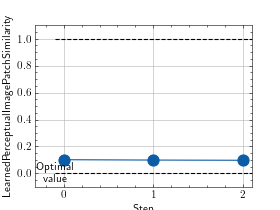Learned Perceptual Image Patch Similarity (LPIPS)¶
Module Interface¶
- class torchmetrics.image.lpip.LearnedPerceptualImagePatchSimilarity(net_type='alex', reduction='mean', normalize=False, **kwargs)[source]
The Learned Perceptual Image Patch Similarity (LPIPS_) calculates the perceptual similarity between two images.
LPIPS essentially computes the similarity between the activations of two image patches for some pre-defined network. This measure has been shown to match human perception well. A low LPIPS score means that image patches are perceptual similar.
Both input image patches are expected to have shape
(N, 3, H, W). The minimum size of H, W depends on the chosen backbone (see net_type arg).Note
using this metrics requires you to have
lpipspackage installed. Either install aspip install torchmetrics[image]orpip install lpipsNote
this metric is not scriptable when using
torch<1.8. Please update your pytorch installation if this is a issue.As input to
forwardandupdatethe metric accepts the following inputimg1(Tensor): tensor with images of shape(N, 3, H, W)img2(Tensor): tensor with images of shape(N, 3, H, W)
As output of forward and compute the metric returns the following output
lpips(Tensor): returns float scalar tensor with average LPIPS value over samples
- Parameters:
net_type¶ (
Literal['vgg','alex','squeeze']) – str indicating backbone network type to use. Choose between ‘alex’, ‘vgg’ or ‘squeeze’reduction¶ (
Literal['sum','mean']) – str indicating how to reduce over the batch dimension. Choose between ‘sum’ or ‘mean’.normalize¶ (
bool) – by default this isFalsemeaning that the input is expected to be in the [-1,1] range. If set toTruewill instead expect input to be in the[0,1]range.kwargs¶ (
Any) – Additional keyword arguments, see Advanced metric settings for more info.
- Raises:
ModuleNotFoundError – If
lpipspackage is not installedValueError – If
net_typeis not one of"vgg","alex"or"squeeze"ValueError – If
reductionis not one of"mean"or"sum"
Example
>>> import torch >>> _ = torch.manual_seed(123) >>> from torchmetrics.image.lpip import LearnedPerceptualImagePatchSimilarity >>> lpips = LearnedPerceptualImagePatchSimilarity(net_type='squeeze') >>> # LPIPS needs the images to be in the [-1, 1] range. >>> img1 = (torch.rand(10, 3, 100, 100) * 2) - 1 >>> img2 = (torch.rand(10, 3, 100, 100) * 2) - 1 >>> lpips(img1, img2) tensor(0.1046, grad_fn=<SqueezeBackward0>)
- plot(val=None, ax=None)[source]
Plot a single or multiple values from the metric.
- Parameters:
val¶ (
Union[Tensor,Sequence[Tensor],None]) – Either a single result from calling metric.forward or metric.compute or a list of these results. If no value is provided, will automatically call metric.compute and plot that result.ax¶ (
Optional[Axes]) – An matplotlib axis object. If provided will add plot to that axis
- Return type:
- Returns:
Figure and Axes object
- Raises:
ModuleNotFoundError – If matplotlib is not installed
>>> # Example plotting a single value >>> import torch >>> from torchmetrics.image.lpip import LearnedPerceptualImagePatchSimilarity >>> metric = LearnedPerceptualImagePatchSimilarity(net_type='squeeze') >>> metric.update(torch.rand(10, 3, 100, 100), torch.rand(10, 3, 100, 100)) >>> fig_, ax_ = metric.plot()

>>> # Example plotting multiple values >>> import torch >>> from torchmetrics.image.lpip import LearnedPerceptualImagePatchSimilarity >>> metric = LearnedPerceptualImagePatchSimilarity(net_type='squeeze') >>> values = [ ] >>> for _ in range(3): ... values.append(metric(torch.rand(10, 3, 100, 100), torch.rand(10, 3, 100, 100))) >>> fig_, ax_ = metric.plot(values)

